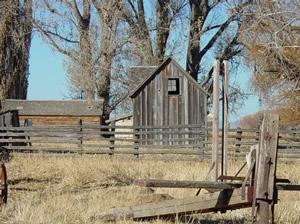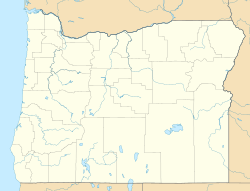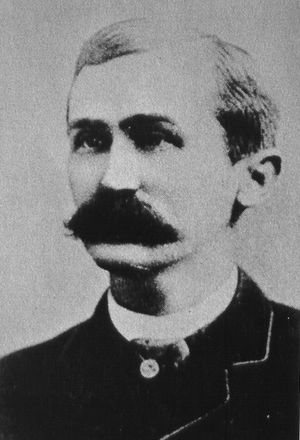Sod House Ranch facts for kids
Quick facts for kids |
|
|
Sod House Ranch
|
|

Original buckaroo bunkhouse
|
|
| Location | Malheur National Wildlife Refuge |
|---|---|
| Nearest city | Burns, Oregon, USA |
| Built | ca. 1880s to 1900 |
| Architectural style | Simple vernacular |
| NRHP reference No. | 79002061 |
| Added to NRHP | 1979 |
The Sod House Ranch is a historic ranch located in southeastern Oregon, United States. You can find its old buildings south of Malheur Lake within the Malheur National Wildlife Refuge. A famous cattle rancher from the 1800s, Peter French, built this ranch.
The Sod House Ranch became the main office for the northern part of the French-Glenn Livestock Company. This huge company eventually owned more than 140,000 acres (56,656 hectares) of land. After Peter French died in 1897, the company slowly sold off its properties. In 1935, the U.S. Government bought the Sod House Ranch. They added it to the nearby wildlife refuge. Today, the eight buildings that are left at the Sod House Ranch are listed on the National Register of Historic Places. This means they are important historical sites.
Contents
Early History of the Harney Basin
The Sod House Ranch is in the Harney Basin area of southeastern Oregon. A very long time ago, about 9,800 years ago, a huge lake covered about 255,000 acres (103,195 hectares) here. This wetland area was full of birds, animals, and plants. These provided lots of food for the first people who lived there.
About 3,500 years ago, small villages started to appear around the lakes and rivers. Then, about 1,400 years ago, long dry periods caused the lake and wetlands to shrink.
We don't have written records of the very first people in the Harney Basin. But we know that Native American groups used the wetlands around Malheur Lake, Harney Lake, and the Donner und Blitzen River for thousands of years. By the time European settlers arrived in the early 1800s, the Northern Paiute people were living in the Harney Basin.
The first Europeans to visit were fur trappers from the Hudson's Bay Company. Peter Skene Ogden traveled along the north shore of Malheur Lake in 1826. Other fur trapping groups came in the 1830s. Later, in the late 1850s, military groups explored the area. Major Enoch Steen was the first non-native person to explore the Donner und Blitzen River area in 1860. Steens Mountain, a large mountain in southern Harney County, is named after him. In the 1860s, the United States Army built several military outposts in the Harney Basin.
Peter French: The Cattle Baron
Peter French was born in Missouri in 1849. His family moved to California in 1850. When he was young, French worked for Doctor Hugh J. Glenn. Dr. Glenn owned a lot of land in the Sacramento Valley. In 1872, Dr. Glenn decided to expand his cattle business into Oregon. He chose 23-year-old Peter French to lead this new project. French traveled north with six vaqueros and 1,200 cattle.
In the Blitzen Valley, French met a prospector named Porter. Porter hadn't found much gold and wanted to leave. French bought Porter's small group of cattle. He also bought Porter's "P" cattle brand and his rights to the west side of Steens Mountain. French settled along the Donner und Blitzen River. Over the next few years, he drained and fenced thousands of acres of wetlands there. This land became known as the P Ranch, named after Porter's "P" brand.
In 1877, French bought the 43,000-acre (17,401-hectare) Sod House Ranch from A. H. Robie. This included Robie's land in the Diamond and Blitzen valleys. By the 1880s, the ranch was making a lot of money for Dr. Glenn. Cattle were raised in the rich valley pastures. In the fall, French would drive his cattle 200 miles (320 km) to the train station in Winnemucca, Nevada.
In 1883, French married Ella, Dr. Glenn's daughter. Sadly, Dr. Glenn was murdered three weeks later by a former employee. French continued to manage the Oregon ranch for the Glenn family. He sold more cattle to help pay off the family's debts. In 1894, Dr. Glenn's children decided to make the French-Glenn partnership into a company called the French-Glenn Livestock Company. French became the company president.
Over the years, French made the company's land even bigger. The ranch stretched 40 miles (64 km) from the Steens Mountain foothills along both sides of the Donner und Blitzen River to Malheur Lake. This included the Sod House Ranch land along the south shore of the lake. It also covered all of the Happy and Diamond valleys nearby, plus a large part of the Catlow Valley to the south.
Eventually, the French-Glenn Livestock Company owned over 140,000 acres (56,656 hectares) of the Harney Basin. Some records even say it might have been as much as 200,000 acres (80,937 hectares). The company built 500 miles (800 km) of barbed wire fence. They had 30,000 to 45,000 cattle, plus 3,000 horses and mules. Besides the main P Ranch, the company had four other divisions: Happy Valley, Diamond, Catlow Valley, and Sod House. The Sod House Ranch was French's smaller headquarters at the northern end of the property. It was near the Donner und Blitzen River's mouth and along the south shore of Malheur Lake.
French was not popular with new settlers in the area. This was because he owned or controlled most of the water in the southern Harney Basin. His fences also made it hard for some settlers to get to their own land. On December 26, 1897, French was shot dead near the Sod House Ranch. He was killed by a settler who had tried and failed to get a road built across French's property.
After French's death, F. C. Lusk, the company's secretary, became the ranch manager. Lusk slowly sold off the ranch's properties to pay the company's debts. In 1906, much of the French-Glenn land, including the Sod House Ranch, was sold to Henry L. Corbett and his partner C.E.S. Wood. In 1916, the Eastern Oregon Live Stock Company bought the property. In the 1920s, John Jenkins bought the part of the property known as the Barton Lake Ranch. This land includes the famous Pete French Round Barn. Finally, in 1935, the United States Government bought the rest of the property. They added it to expand the Malheur National Wildlife Refuge.
Malheur National Wildlife Refuge
The Malheur Migratory Bird Refuge was created in 1908. Over the years, the refuge grew to cover 81,786 acres (33,098 hectares) around Malheur Lake. In 1935, the United States Government bought 64,717 acres (26,190 hectares) from the Eastern Oregon Live Stock Company for $675,000. This land was added to the refuge. The refuge was later renamed the Malheur National Wildlife Refuge.
In the 1930s, the refuge had three Civilian Conservation Corps (CCC) camps. These camps were at the Sod-House Ranch, Buena Vista Station, and 5 miles (8 km) north of Frenchglen in the P Ranch area. CCC workers built many stone buildings for the refuge headquarters near the Sod House site. They also built refuge buildings at Buena Vista, four lookout towers, the main refuge patrol road, four concrete dams, many canals and bridges, and hundreds of miles of fence. The camps closed in 1942.
The Sod House Ranch was very important in the history of the cattle industry in the western United States. Because of this, it was listed on the National Register of Historic Places as a historic district on January 29, 1979. The historic district covers 10 acres (4 hectares). Today, eight of the ten original ranch buildings, plus three other historic structures, are still at the site. Most of these old buildings are in good condition.
Ranch Buildings and Structures
The Sod House Ranch complex originally had ten buildings. These ranch buildings were built between the early 1880s and 1900. Today, eight of those buildings and several other historic structures remain. These include the main house, a buckaroo bunkhouse, a large barn, a workshop, a carriage shed, a chicken coop with a grain storage shed, a stone cellar, a small cabin, a beef wheel, and some original stockade fences. Many large cottonwood trees surround the ranch site. Emanuel Clark, French's Sod House Ranch foreman, planted these trees in 1892.
The Sod House Ranch buildings were made using materials found nearby. These included pine and aspen wood, juniper posts, and local stone. Most of the buildings have been repaired, had new roofs, or been restored. But all of them still look like they did originally.
The barn was probably the first building constructed, likely in the early 1880s. It is 120 feet (37 meters) long and 50 feet (15 meters) wide. It's a post and beam structure. Heavy juniper posts hold up the roof, which is 30 feet (9 meters) high at its tallest point. The outside of the barn is made of pine and juniper boards. The roof is covered with pine shingles. The Civilian Conservation Corps replaced the original roof with pine shingles in the 1930s. Inside, the barn is one big room with a wide center aisle. This aisle was used to store hay for winter. Feed racks run along both sides of the barn.
In 1999, the United States Fish and Wildlife Service started a project to fix and restore the barn. They used jacks to lift the barn off the ground. Then, they removed old, broken support posts and replaced them with new juniper posts. Concrete bases were placed under the new posts. The project also lifted parts of the building 23 inches (58 cm) to make them straight again.
At the same time, many groups worked with the U.S. Fish and Wildlife Service to restore other ranch buildings. This restoration work took five years. The Sod House Ranch reopened to the public on October 18, 2003. Some of the partners who helped restore the ranch include the National Park Service, the University of Oregon Architectural Field School, the Oregon Parks and Recreation Department, the Oregon State Historic Preservation Office, AmeriCorps, the National Fish and Wildlife Foundation, the Harney County Historical Society, Malheur Wildlife Associates, the High Desert Museum, and many local volunteer groups.
Today, the Sod House Ranch is open to the public from August 15 through October 15. It is closed for the rest of the year. This is because the area is an important nesting place for large groups of great blue herons, double-crested cormorants, and Canada geese.
Images for kids
Location and Visiting
The Sod House Ranch Historic District is inside the Malheur National Wildlife Refuge in southeastern Oregon. The historic district covers 10 acres (4 hectares). The site is about 1 mile (1.6 km) south of Malheur Lake and 1 mile (1.6 km) west of the Donner und Blitzen River. The ranch is 4,104 feet (1,251 meters) above sea level.
The Sod House Ranch is about 25 miles (40 km) southeast of Burns, Oregon if you go in a straight line. To get there from Burns, travel east on Oregon Route 78 for 2 miles (3.2 km). Then, turn south onto Oregon Route 205. Follow Route 205 for 23 miles (37 km). After that, turn east onto the Narrows-Princeton Road. About 4 miles (6.4 km) from that turn, you will turn south onto the Sod House Ranch access road. Follow this access road for 1 mile (1.6 km) to reach the historic ranch site.









